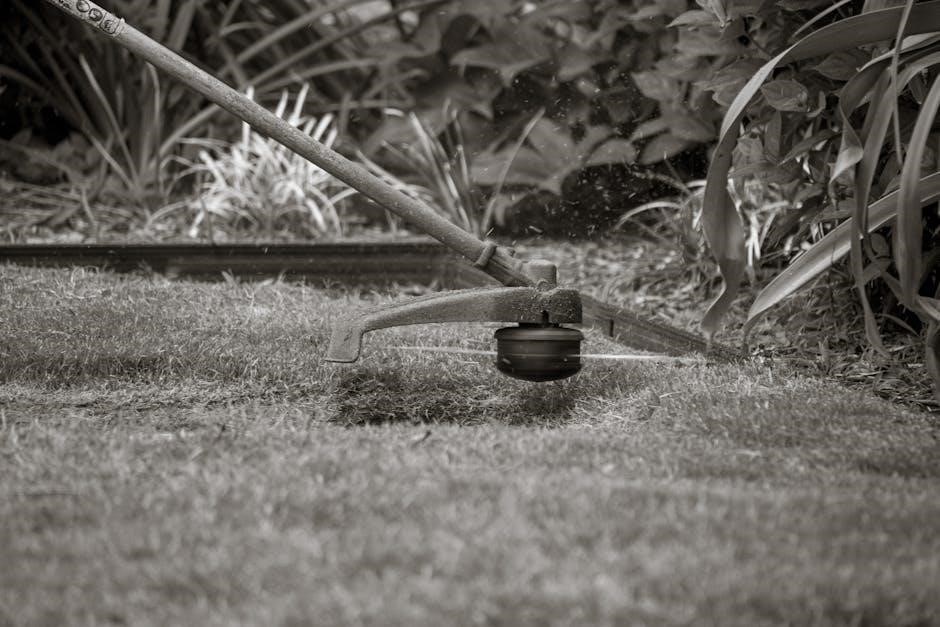Regular lawn mower maintenance is essential for ensuring optimal performance, extending equipment lifespan, and preventing costly repairs. A well-maintained mower delivers better cutting results, reducing strain on the engine and improving efficiency. By following a structured maintenance checklist, homeowners can keep their mowers in top condition, ensuring reliability throughout the cutting season. Proper care also enhances safety, reduces environmental impact, and saves money over time. This guide provides a comprehensive overview of maintenance practices and offers a downloadable Lawn Mower Maintenance Checklist PDF for easy reference.
What is a Lawn Mower Maintenance Checklist?
A lawn mower maintenance checklist is a detailed list of tasks designed to ensure your mower operates efficiently and lasts longer. It outlines regular checks and services, such as oil changes, air filter cleaning, blade sharpening, and deck cleaning. By following this checklist, homeowners can prevent breakdowns, improve cutting performance, and reduce repair costs. Many checklists are available as downloadable PDFs, making it easy to track and complete maintenance tasks. These documents often include step-by-step instructions and schedules, helping users stay organized and ensure their mower is always ready for use. Regular adherence to a checklist maximizes mower performance and longevity.

Essential Lawn Mower Maintenance Tasks
Regular tasks include oil changes, air filter cleaning, blade sharpening, and deck cleaning. These ensure optimal performance, prevent damage, and extend the mower’s lifespan. Consistency is key.
Oil Changes and Lubrication
Regular oil changes are crucial for maintaining your lawn mower’s engine health. Always use the type of oil recommended by the manufacturer. Check the oil level before each use and change it after every 20-50 hours of operation. Old oil can become contaminated and cause engine damage. Dispose of used oil responsibly. Additionally, lubricate moving parts like wheels and pivot points to ensure smooth operation and prevent rust. Refer to your mower’s manual for specific intervals and guidelines. Proper lubrication extends the lifespan of your mower and keeps it running efficiently throughout the cutting season. Consistency is key to longevity.
Air Filter Cleaning and Replacement
A clean air filter is essential for your lawn mower’s engine performance. A dirty filter can reduce power, decrease fuel efficiency, and potentially damage the engine. Regularly inspect and clean the air filter, especially after mowing dusty areas. For foam filters, tap them gently to remove debris and wash with soap and water. Paper filters should be replaced if torn or clogged. Replace the air filter every season or as recommended by the manufacturer. A well-maintained air filter ensures proper airflow, optimal engine function, and extends the life of your mower. Keep a spare filter on hand for quick replacements during maintenance checks.
Sharpening Mower Blades

Sharpening your lawn mower blades is crucial for achieving a clean cut and maintaining healthy grass. Dull blades tear the grass, leading to uneven growth and increased susceptibility to disease. To sharpen the blades, disconnect the spark plug for safety. Remove the blades and use a grinder or file to restore their edge, ensuring they remain balanced. Sharpening should be done at least once a season or more frequently if you mow regularly. Properly sharpened blades improve cutting efficiency, reduce wear on the mower, and promote a lush, even lawn. Always refer to your mower’s manual for specific sharpening guidelines.
Cleaning the Mower Deck
Cleaning the mower deck is essential for maintaining your lawn mower’s efficiency and preventing corrosion. After each use, remove grass clippings, dirt, and debris using a brush or scraper to ensure proper airflow and even cutting. For thorough cleaning, disconnect the spark plug for safety, then rinse the deck with a garden hose; Dry it thoroughly to avoid rust formation. Regular cleaning prevents the buildup of material that can weigh down the mower and reduce its performance. A clean deck also helps maintain the mower’s balance and ensures a consistent cut, keeping your lawn healthy and well-manicured throughout the season.

Seasonal Lawn Mower Maintenance
Seasonal maintenance ensures your lawn mower performs optimally year-round. Spring preparation involves tuning up, while fall and winter focus on storage and protecting the mower from rust and damage.
Spring Mower Preparation
Spring preparation is crucial for ensuring your lawn mower is ready for the cutting season. Start by checking the oil and filters, and replace them if necessary. Sharpen the blades to ensure clean cuts and even grass growth. Clean the mower deck thoroughly to remove any debris from winter storage. Check the tire pressure and cables for damage or wear. Refill the fuel tank with fresh gas, and consider adding a fuel stabilizer if not used for a while. Finally, test the mower to ensure it runs smoothly before the first cut. A well-prepared mower guarantees a healthy, lush lawn.
Fall and Winter Mower Storage

Proper fall and winter storage is vital to protect your lawn mower from damage. Start by draining the fuel tank or adding a fuel stabilizer to prevent corrosion. Disconnect and remove the spark plug for safety. Clean the mower thoroughly, removing dirt and debris from the deck and blades. Apply a rust-inhibiting oil to metal parts and store the mower in a dry, protected area. If using a battery, charge it to 50% capacity and store it separately in a cool place. Follow these steps to ensure your mower remains in excellent condition for the next cutting season.

Fuel System Maintenance
Regular fuel system maintenance ensures optimal performance and prevents engine issues. Tasks include replacing fuel filters, adding stabilizers, and draining fuel for storage to avoid corrosion and clogs.
Fuel Filter Replacement
A clean fuel filter is crucial for maintaining your lawn mower’s performance. Over time, dirt and debris accumulate, restricting fuel flow and potentially causing engine issues. Replacing the fuel filter regularly ensures proper fuel delivery, preventing poor performance, rough idling, or even engine failure. Most manufacturers recommend replacing the fuel filter every 50-100 operating hours or at the start of each mowing season. Use a high-quality filter compatible with your mower’s make and model. Always refer to your owner’s manual for specific instructions, and remember to dispose of old filters responsibly to protect the environment.
Adding Fuel Stabilizer
Adding fuel stabilizer to your lawn mower is a simple yet effective maintenance step, especially during periods of inactivity. Stabilizer prevents gasoline from breaking down, which can lead to clogged fuel lines and carburetor issues. For seasonal storage or extended breaks, mix the stabilizer with fresh fuel as directed by the manufacturer. This ensures the fuel remains usable and protects engine components from corrosion. Regular use of stabilizer can extend the lifespan of your mower and save you from costly repairs. Always follow the recommended ratio and instructions for optimal results and to maintain your mower’s performance.
Draining Fuel for Storage
Draining fuel from your lawn mower before storage is crucial to prevent stale gasoline from causing engine issues. Over time, fuel can degrade, leading to clogged fuel lines and carburetor damage. To drain the fuel, refer to your mower’s manual for specific instructions, as some models may have a drain plug or require siphoning. Alternatively, you can run the mower until the tank is empty. This step ensures your mower remains in good condition during the off-season. Always dispose of drained fuel responsibly and follow safety precautions to avoid spills and environmental contamination.

Battery Maintenance
Regular battery inspections and charging are vital for optimal mower performance. Ensure terminals are clean, and store batteries in a cool, dry place during off-seasons. Always refer to the manufacturer’s guide for specific charging instructions to maintain battery health and longevity.
Charging and Load Testing
Charging and load testing are critical steps in maintaining your lawn mower’s battery health. Start by ensuring the charger is compatible with your battery type. Disconnect the battery from the mower and connect it to the charger, following the manufacturer’s instructions. Allow the battery to charge fully, typically indicated by a green light or a reading of 12.6 volts for a fully charged state. After charging, perform a load test to assess the battery’s capacity. This can be done using a load tester, which simulates the electrical load of the mower. If the voltage drops below 10 volts during the test, the battery may need replacement. Regular charging and testing help prevent sudden failures and ensure reliable starting. Always refer to your mower’s manual for specific guidelines, and consider taking the battery to a professional if you’re unsure. Proper charging and testing not only extend the battery’s lifespan but also ensure your mower is ready for the next use. Additionally, during the off-season, charge the battery every 30 days to maintain its health and prevent deep discharge, which can shorten its lifespan. By staying proactive with charging and load testing, you can avoid unexpected issues and keep your mower running smoothly year-round.
Battery Storage Tips
Proper battery storage is vital for maintaining your lawn mower’s performance and longevity. Store the battery in a cool, dry place away from direct sunlight and flammable materials. Ensure the terminals are clean and protected from corrosion by applying a thin layer of petroleum jelly. Avoid storing the battery in extreme temperatures, as this can drain its capacity. If the battery is removable, keep it away from conductive materials like metal tools to prevent accidental short circuits. Before storage, charge the battery to 100% to prevent deep discharge, which can reduce its lifespan. Check the voltage periodically to ensure it remains stable. This helps maintain the battery’s health and ensures it’s ready for the next cutting season. Proper storage practices not only extend the battery’s life but also enhance safety and reliability. Always refer to your mower’s manual for specific storage recommendations, as different battery types may require unique care. By following these tips, you can keep your lawn mower’s battery in optimal condition year-round.

Safety Guidelines
Always wear protective gear like gloves, safety glasses, and ear protection when operating or maintaining your lawn mower. Ensure the area is clear of debris and bystanders. Operate the mower on level ground and avoid steep slopes to prevent accidents. Keep loose clothing tied back and long hair secured. Never let children or untrained individuals operate the mower. Follow all manufacturer guidelines and safety precautions to minimize risks and ensure a safe mowing experience. Regular maintenance also plays a crucial role in maintaining safety by preventing equipment failure during use.
Personal Protective Equipment
Wearing proper personal protective equipment (PPE) is crucial for safety while maintaining or operating a lawn mower. Always wear gloves to protect your hands from cuts and abrasions. Safety glasses or goggles are essential to shield your eyes from debris. Additionally, wear ear protection to minimize noise exposure, especially with loud mowers. Sturdy footwear or steel-toe boots can prevent injuries from heavy objects or sharp edges. Long pants and long-sleeve shirts can also protect skin from flying debris. Ensure all PPE is worn correctly and remains secure during use. This gear helps prevent accidents and ensures a safer mowing experience.
Safe Operating Practices
Always ensure the lawn mower is on a level surface and the parking brake is engaged before starting. Clear the area of debris, toys, or loose objects to prevent accidental damage or injury. Maintain a steady pace and avoid sudden turns or acceleration. Keep children and pets at a safe distance while mowing. Never operate the mower while fatigued or distracted. Use the correct mowing pattern for your lawn type to maintain even cutting and prevent leaving clumps of grass. Keep the mower deck at the recommended height to avoid scalping the lawn. Regularly inspect for loose parts or damage before use.

Storage and Transportation Tips
Proper storage involves cleaning the mower and keeping it dry. Use fuel stabilizer for storage and ensure safe transportation by securing the mower and protecting blades.
Proper Storage Conditions
Store your lawn mower in a clean, dry, and well-ventilated area to prevent rust and moisture damage. Before storage, clean the mower deck and underside to remove grass clippings and debris; Disconnect the spark plug for safety and apply fuel stabilizer if storing for an extended period. Avoid storing the mower in direct sunlight or extreme temperatures. Place the mower on a level surface and consider elevating it to protect the blade and underside. Ensure the fuel tank is empty or treated with stabilizer to prevent fuel breakdown. Proper storage conditions help maintain your mower’s performance and longevity.
Transporting the Mower Safely
When transporting your lawn mower, ensure it is securely fastened to prevent movement during transit. Always disconnect the spark plug and drain the fuel tank or add stabilizer to prevent spills. Choose a sturdy trailer or vehicle with adequate tie-down points. Cover the mower to protect it from dust and debris. Avoid transporting the mower while it is in operation. For riding mowers, use ramps designed for heavy equipment and ensure the area is clear of obstacles. Proper transportation practices safeguard both the mower and other road users, ensuring safe and efficient relocation.

Troubleshooting Common Issues
Identify and address issues promptly to maintain performance. Check the manual for solutions to starting problems, blade damage, or unusual noises. Refer to the downloadable Lawn Mower Maintenance Checklist PDF for guidance.
Starting Problems
Starting issues are common and often linked to fuel, air filters, or spark plugs. Check for stale fuel, as it can clog the carburetor. Ensure the air filter is clean or replaced, as a dirty filter restricts airflow. Verify the spark plug is clean and properly gapped. If the battery is used, test its charge and connections. Refer to the lawn mower maintenance checklist PDF for troubleshooting steps. Always disconnect the spark plug before servicing to ensure safety. Addressing these areas can resolve most starting problems and get your mower running smoothly again. Regular checks prevent such issues from arising.
Performance Issues
Performance issues in lawn mowers can stem from dull blades, clogged decks, or improper cutting heights. Dull blades tear grass, leaving it vulnerable to disease, while clogged decks reduce airflow, affecting cut quality. Check and sharpen blades regularly, ensuring they are balanced. Clean the mower deck after each use to prevent debris buildup. Adjust the mowing height according to grass type and season. Refer to the lawn mower maintenance checklist PDF for detailed guidance. Addressing these factors ensures a clean, even cut and maintains healthy grass. Regular blade sharpening and deck maintenance are critical for optimal performance and longevity of the mower.
Strange Noises
Strange noises from a lawn mower can indicate underlying issues that need immediate attention. Common causes include loose bolts, debris in the mower deck, or dull blades striking uneven surfaces. A rattling sound may signal loose parts, while a grinding noise could point to issues with the blade or spindle. Regularly inspect and tighten all bolts, and clear debris from the deck. Sharpen or replace dull blades to prevent vibration and damage. Refer to the lawn mower maintenance checklist PDF for guidance on diagnosing and resolving noise-related problems. Addressing these issues ensures smooth operation and prevents further damage.
Regular lawn mower maintenance ensures optimal performance, extends lifespan, and reduces repair costs. Use the downloadable Lawn Mower Maintenance Checklist PDF for a well-organized care routine.
Benefits of Regular Maintenance
Regular lawn mower maintenance offers numerous benefits, including improved performance, extended equipment lifespan, and reduced repair costs. A well-maintained mower operates more efficiently, cuts cleaner, and requires less fuel. It also enhances safety by preventing unexpected malfunctions. Additionally, proper care reduces environmental impact by minimizing emissions and waste. Over time, consistent maintenance saves money by avoiding costly repairs and prolonging the mower’s usability. By following a structured maintenance checklist, homeowners can enjoy a perfectly manicured lawn with less effort and stress. Downloading a Lawn Mower Maintenance Checklist PDF ensures you never miss critical tasks, keeping your mower in optimal condition year-round.
Downloadable Lawn Mower Maintenance Checklist PDF
Downloadable Lawn Mower Maintenance Checklist PDF
A downloadable Lawn Mower Maintenance Checklist PDF is a practical tool for homeowners and professionals alike. This document provides a structured schedule of essential tasks, ensuring your mower remains in peak condition. It includes sections for oil changes, blade sharpening, air filter replacements, and more. The PDF is designed to be printed or saved digitally, making it easy to track progress. With checkboxes and space for notes, it’s a handy reference for seasonal and routine upkeep. By following this checklist, you can prevent breakdowns, extend equipment life, and keep your lawn looking its best all year round. Download yours today!
